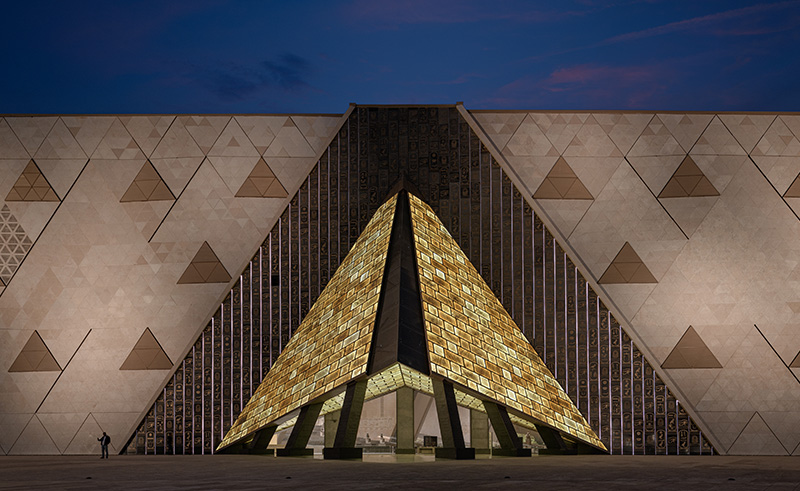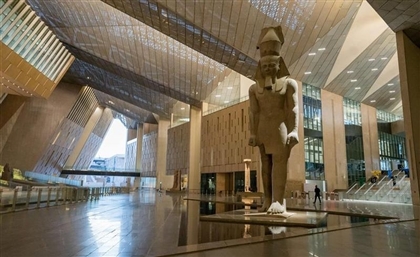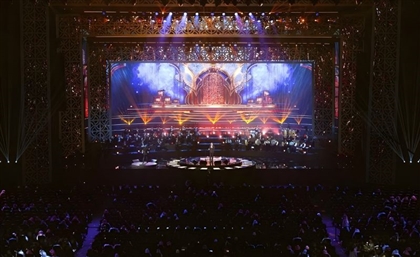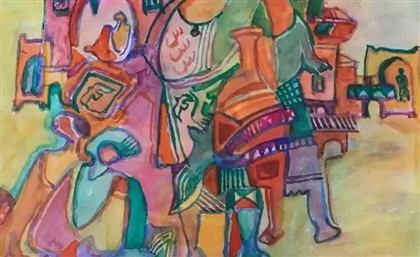Beyond the Natural Stone of the Grand Egyptian Museum
This is how Cairo-based Hossam Zeitoun Contractors coated the highly anticipated museum with natural beauty.

Originally Published on Sep 13, 2023
The Grand Egyptian Museum’s (GEM) opening is Egypt’s most anticipated event of the year, if not the decade. The largest museum dedicated to a single civilisation has the world on the edge of its cosmic seat to view the incomprehensible wealth of Egyptian heritage under one roof. Much like the artefacts contained within, the museum’s slanted ceiling was made of locally-sourced natural stone - although in this case, it has been sliced with (quite literally) cutting-edge technology by Cairo-based marble manufacturers Hossam Zeitoun Natural Stone Contractors.
-31418e12-9bd8-41e5-985e-ed660a006703.jpg) Also known as Marble Art Egypt and El Sarh, Hossam Zeitoun Contractors is managed by architect Hossam and engineer Faten Zeitoun. With two manufacturing plants, the marble manufacturers offer custom fabrication and installation in Egypt, the UAE, Qatar and Saudi Arabia, as well as Italy, Greece, Singapore, USA and China, amongst others.
Also known as Marble Art Egypt and El Sarh, Hossam Zeitoun Contractors is managed by architect Hossam and engineer Faten Zeitoun. With two manufacturing plants, the marble manufacturers offer custom fabrication and installation in Egypt, the UAE, Qatar and Saudi Arabia, as well as Italy, Greece, Singapore, USA and China, amongst others.
-3d311d73-6a6b-4839-bc82-0bda1e9e4f19.jpg) “Our aim is to create an everlasting culture of natural stone appreciation,” Mariam Zeitoun, Creative Director and Managing Partner, tells SceneHome. “The world of natural stone is vast and wondrous. We take pride in constantly adapting to meet technological advances that help produce a wonderful stone-clad world.”
“Our aim is to create an everlasting culture of natural stone appreciation,” Mariam Zeitoun, Creative Director and Managing Partner, tells SceneHome. “The world of natural stone is vast and wondrous. We take pride in constantly adapting to meet technological advances that help produce a wonderful stone-clad world.”
-e6e7d71d-bdac-4ea8-917b-4c286c118656.jpg) Dedicated to natural stone design, supply and installation since 1979, Hossam Zeitoun has been developing state-of-the-art solutions in the industry, both locally and globally. Hossam Zeitoun sources their materials from all over the globe, from Argentina and Italy to the Philippines. But when it came to the Grand Egyptian Museum, they went back to the roots.
Dedicated to natural stone design, supply and installation since 1979, Hossam Zeitoun has been developing state-of-the-art solutions in the industry, both locally and globally. Hossam Zeitoun sources their materials from all over the globe, from Argentina and Italy to the Philippines. But when it came to the Grand Egyptian Museum, they went back to the roots.
-efaec9d6-b38d-4748-832f-eb04fc4ecf84.jpg) “This is a monument of Egyptian heritage. We were keen on using locally sourced materials to ensure authenticity and sustainability,” Zeitoun says, pointing to the materials used to clad the stiletto (slanted ceiling) that hovers over the museum, as well as the Temple Garden pavement, ripple benches, retaining walls, restaurant flooring and facade cladding. Approximately 25,000 sqm of surfaces were covered with their natural stone.
“This is a monument of Egyptian heritage. We were keen on using locally sourced materials to ensure authenticity and sustainability,” Zeitoun says, pointing to the materials used to clad the stiletto (slanted ceiling) that hovers over the museum, as well as the Temple Garden pavement, ripple benches, retaining walls, restaurant flooring and facade cladding. Approximately 25,000 sqm of surfaces were covered with their natural stone.
-6ccb398b-8852-45b5-adb0-7b5ebc867ccd.jpg) The Grand Egyptian Museum was, understandably, highly sought after by the world’s most prominent marble manufacturers. “We were officially chosen after presenting a technique developed in-house called ‘Slim Panelling’,” Zeitoun says. The state-of-the-art technology slices the blocks into slabs of stone as thin as 5-6mm, fused to sandwich panels. “It saves cost and is extremely efficient in creating the effect desired by the architects in the main facade,” she adds, referring to the Heneghan Peng Architects design.
The Grand Egyptian Museum was, understandably, highly sought after by the world’s most prominent marble manufacturers. “We were officially chosen after presenting a technique developed in-house called ‘Slim Panelling’,” Zeitoun says. The state-of-the-art technology slices the blocks into slabs of stone as thin as 5-6mm, fused to sandwich panels. “It saves cost and is extremely efficient in creating the effect desired by the architects in the main facade,” she adds, referring to the Heneghan Peng Architects design.
-cdec6237-fc79-441d-ac0c-d26cc8c12825.jpg) Initially, the design’s facades were completely onyx backlit. This was narrowed down to a more simplified solution; only the pyramid-shaped entrances were to have the feature, with Egyptian limestone cladding the rest of the facade. The same technique was used for the challenging stiletto ceiling.
Initially, the design’s facades were completely onyx backlit. This was narrowed down to a more simplified solution; only the pyramid-shaped entrances were to have the feature, with Egyptian limestone cladding the rest of the facade. The same technique was used for the challenging stiletto ceiling.
-94686677-343f-4ee5-81d5-f694d7127c68.jpg) Slim stone panels are ultra-thin and light sheets of natural stone; a fusion between thin stone slabs and durable reinforcement panels. The panels used in GEM possess an unmatched stiffness-density ratio when used in sandwich construction. The result is an efficient, consistent, lightweight structure. “They assist in envisioning designers’ creations into reality, making stone more reliable and flexible,” Zeitoun says. “The stiletto ceiling, which is slanted and hovers over the museum, requires lightweight tiles that are perfectly fixed.”
Slim stone panels are ultra-thin and light sheets of natural stone; a fusion between thin stone slabs and durable reinforcement panels. The panels used in GEM possess an unmatched stiffness-density ratio when used in sandwich construction. The result is an efficient, consistent, lightweight structure. “They assist in envisioning designers’ creations into reality, making stone more reliable and flexible,” Zeitoun says. “The stiletto ceiling, which is slanted and hovers over the museum, requires lightweight tiles that are perfectly fixed.”
Hossam Zeitoun managed to reduce marble thickness to a minimum, achieving a light weight which was reinforced with aluminum honeycomb to ensure its durability. “We strive to look for nature’s beautiful harvests and bring them home,” Zeitoun says. Amber onyx was used for the backlit pyramid-shaped entrances. Egyptian limestone, also known as Trieste limestone, was used on the facade, while Egyptian granite was used for the monument pedestals.
“Amber onyx and alabaster have always been used in ancient Egyptian artifacts. The gold colour of the stone reflects warmth and richness, glowing vibrantly when backlit as the sun sets,” Zeitoun says, describing the feature that allows the museum to appear as a landmark from a distance.
-0981a083-a952-4db2-b67b-fc1836a67f05.jpg) Floorings and claddings are made of the famous Trieste limestone, sourced from various Egyptian quarries. “The beige colour helps it blend with the surrounding environment. Earthy colours reflect Egyptian colour palettes, blending with the Great Pyramids of Giza, which are seen from the museum,” Zeitoun explains. “Seeing how in awe everyone feels of the museum’s grandeur is very satisfying. It’s a proud moment to realise that we’ve taken part in accomplishing a valuable addition to modern and ancient Egyptian heritage.”
Floorings and claddings are made of the famous Trieste limestone, sourced from various Egyptian quarries. “The beige colour helps it blend with the surrounding environment. Earthy colours reflect Egyptian colour palettes, blending with the Great Pyramids of Giza, which are seen from the museum,” Zeitoun explains. “Seeing how in awe everyone feels of the museum’s grandeur is very satisfying. It’s a proud moment to realise that we’ve taken part in accomplishing a valuable addition to modern and ancient Egyptian heritage.”
Hossam Zeitoun has made it common practice to participate in national projects that often attract global attention to Egypt’s wealth of heritage. From their contributions to international airports such as Luxor International Airport and Cairo International Airport to the New Administrative Capital’s Opera House and the Marriott Zamalek Gardens and the renovation of Moez St. But those are stories for another day.
Photography Credit: Nour El Refai
- Previous Article Egypt’s ‘Kultured Glass’ Asks You to Wear Your Heart on Your Head
- Next Article Six Unexpected Natural Wonders to Explore in Egypt
Trending This Week
-
Dec 16, 2025



























